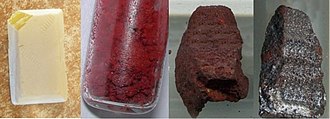Phosphorus
From W8MD weight loss and sleep centers
Phosphorus is a chemical element that is essential for life. It is the 15th most abundant element in the Earth's crust and is found in a variety of minerals and organic compounds. In this article, we will explore the properties and uses of phosphorus, its role in the human body, and its impact on the environment.
Properties and Uses of Phosphorus
- Phosphorus is a highly reactive non-metallic element that is found in three main forms: white, red, and black. White phosphorus is a waxy substance that ignites spontaneously in air, while red phosphorus is a less reactive form that is used in the production of matches and other chemicals. Black phosphorus is a crystalline form that is used in semiconductor devices and other electronic applications.
- Phosphorus has numerous industrial and agricultural uses. It is used in the production of fertilizers, detergents, and other chemicals. It is also used in the production of steel and other metals, as well as in the manufacture of electronic components and semiconductors.
Role of Phosphorus in the Human Body
- Phosphorus is an essential nutrient that is required for the growth, repair, and maintenance of bones and other tissues in the body. It is also involved in numerous biochemical processes, including the production of ATP (adenosine triphosphate), the primary energy source for cells.
- The body obtains phosphorus from the diet, primarily through the consumption of foods such as dairy products, meat, fish, and whole grains. The body regulates the levels of phosphorus in the blood through a complex system that involves the kidneys, parathyroid gland, and bones.
Impact of Phosphorus on the Environment
- Phosphorus is an important nutrient for plant growth, and is often added to soil in the form of fertilizers to improve crop yields. However, excessive use of phosphorus fertilizers can lead to environmental problems such as eutrophication, a process in which high levels of nutrients in water bodies can cause algae blooms and other harmful effects.
- In addition to fertilizers, other sources of phosphorus pollution include wastewater from industrial and agricultural operations, as well as runoff from urban areas. To reduce the impact of phosphorus on the environment, it is important to use fertilizers and other sources of phosphorus responsibly, and to implement measures to reduce nutrient pollution in water bodies.
Also see
This is a short summary article. For quality control, we do not encourage or allow strangers to edit the content.

